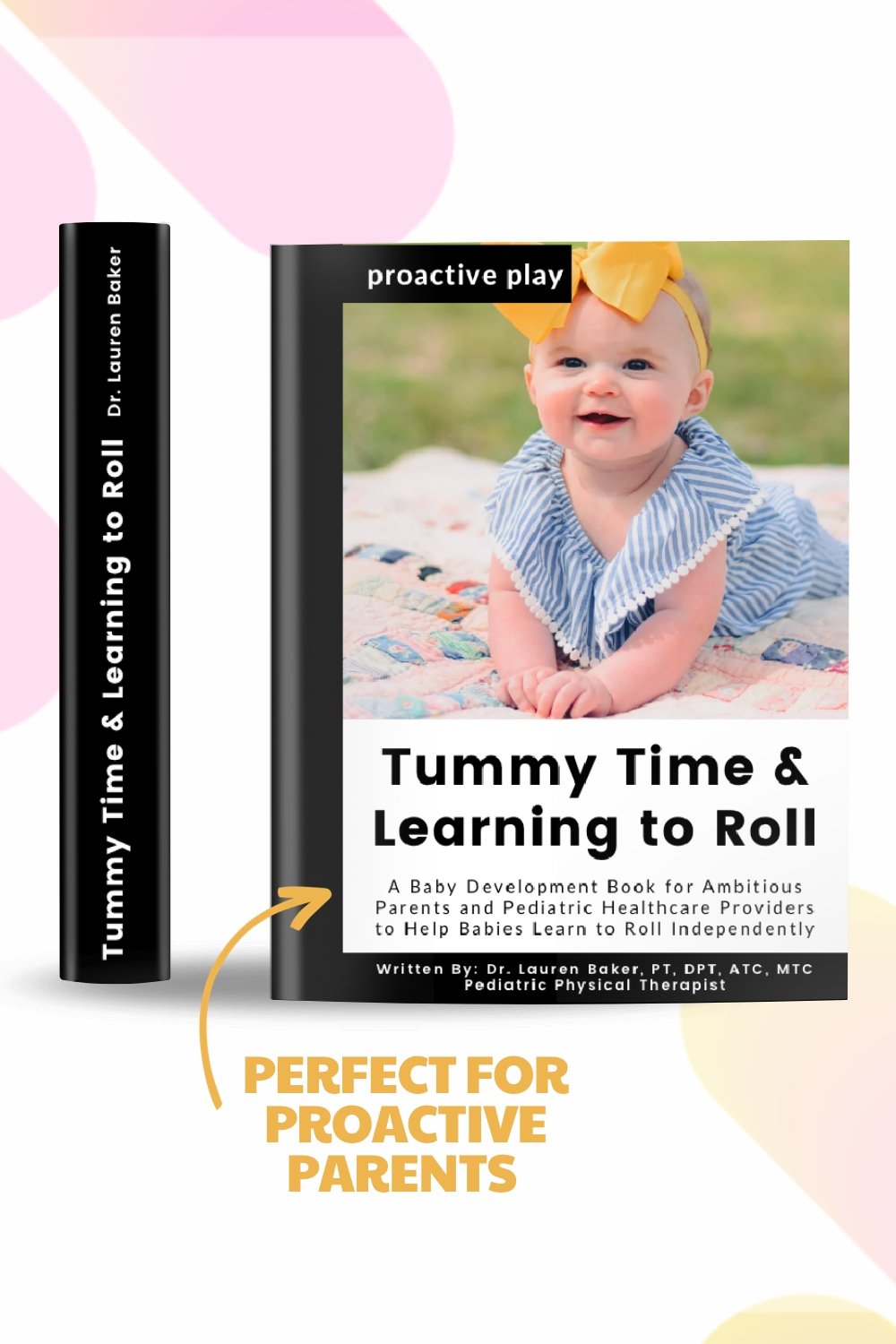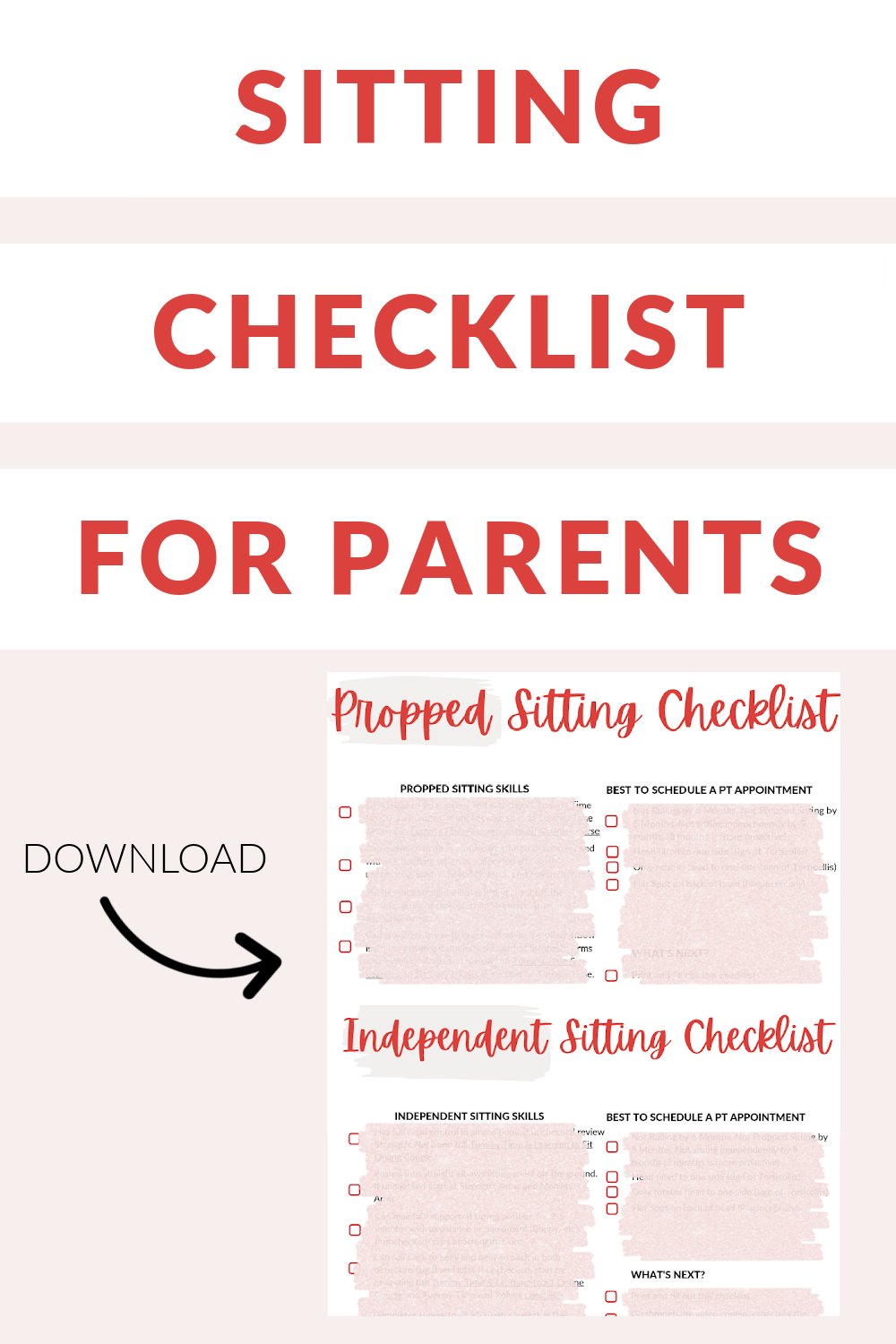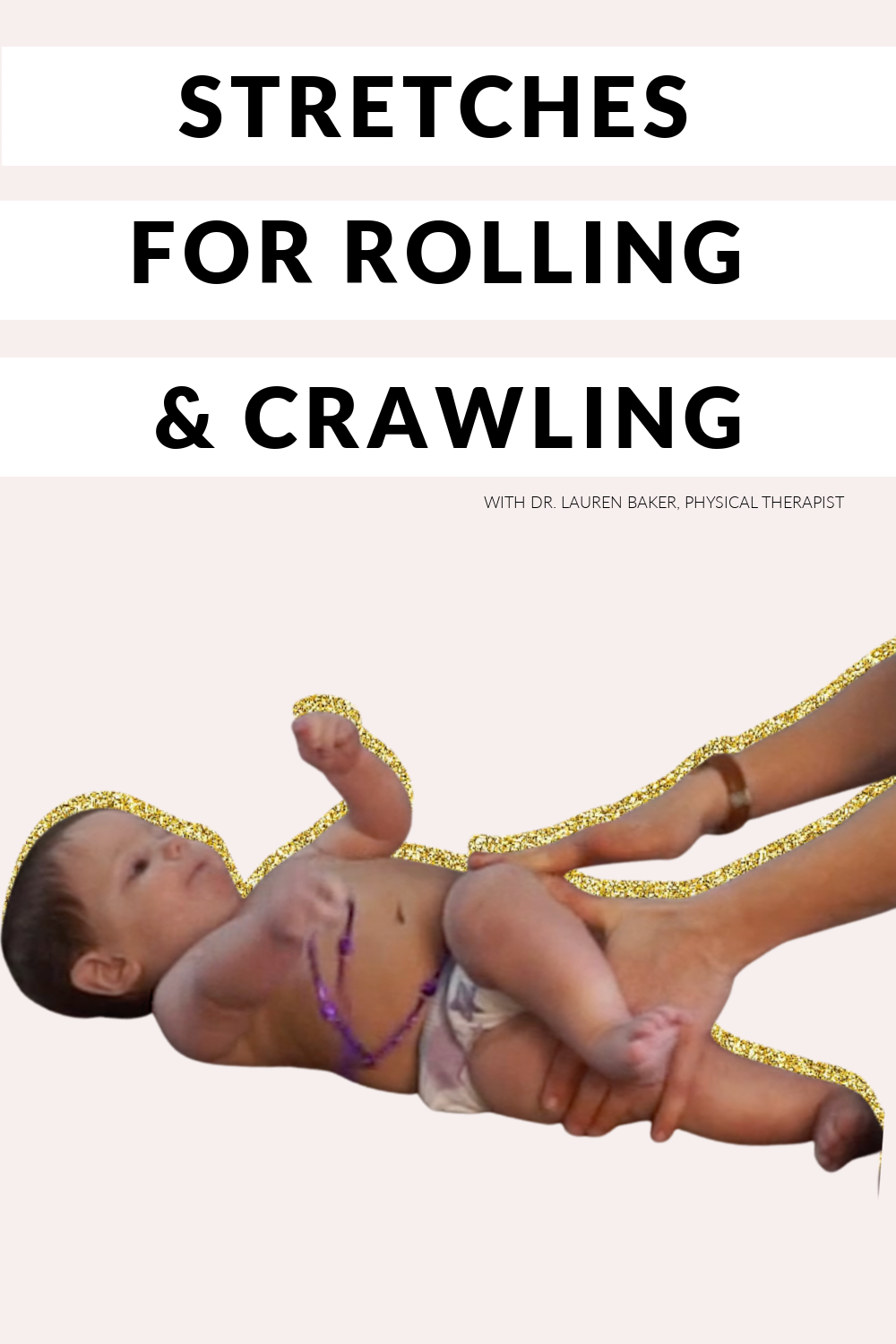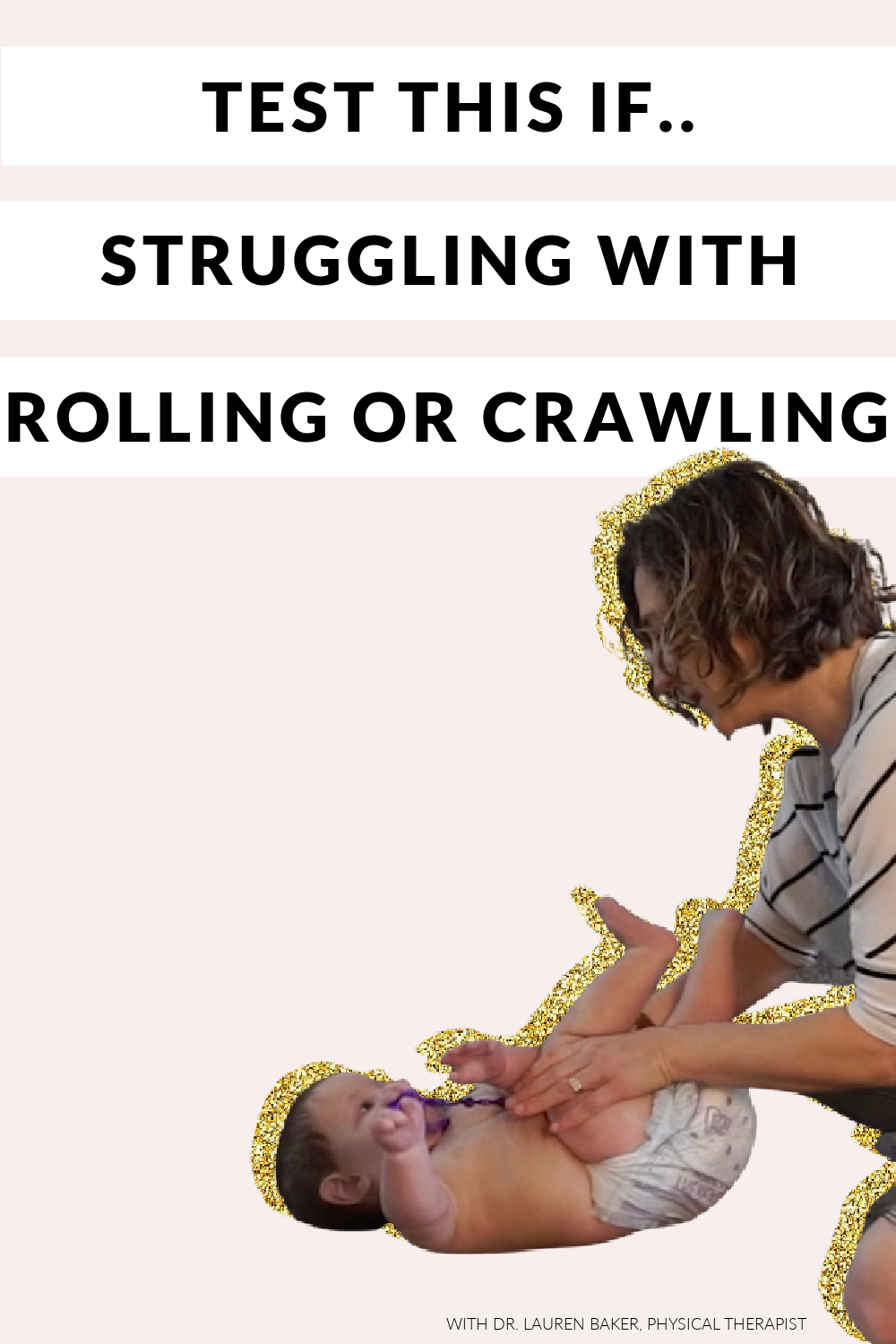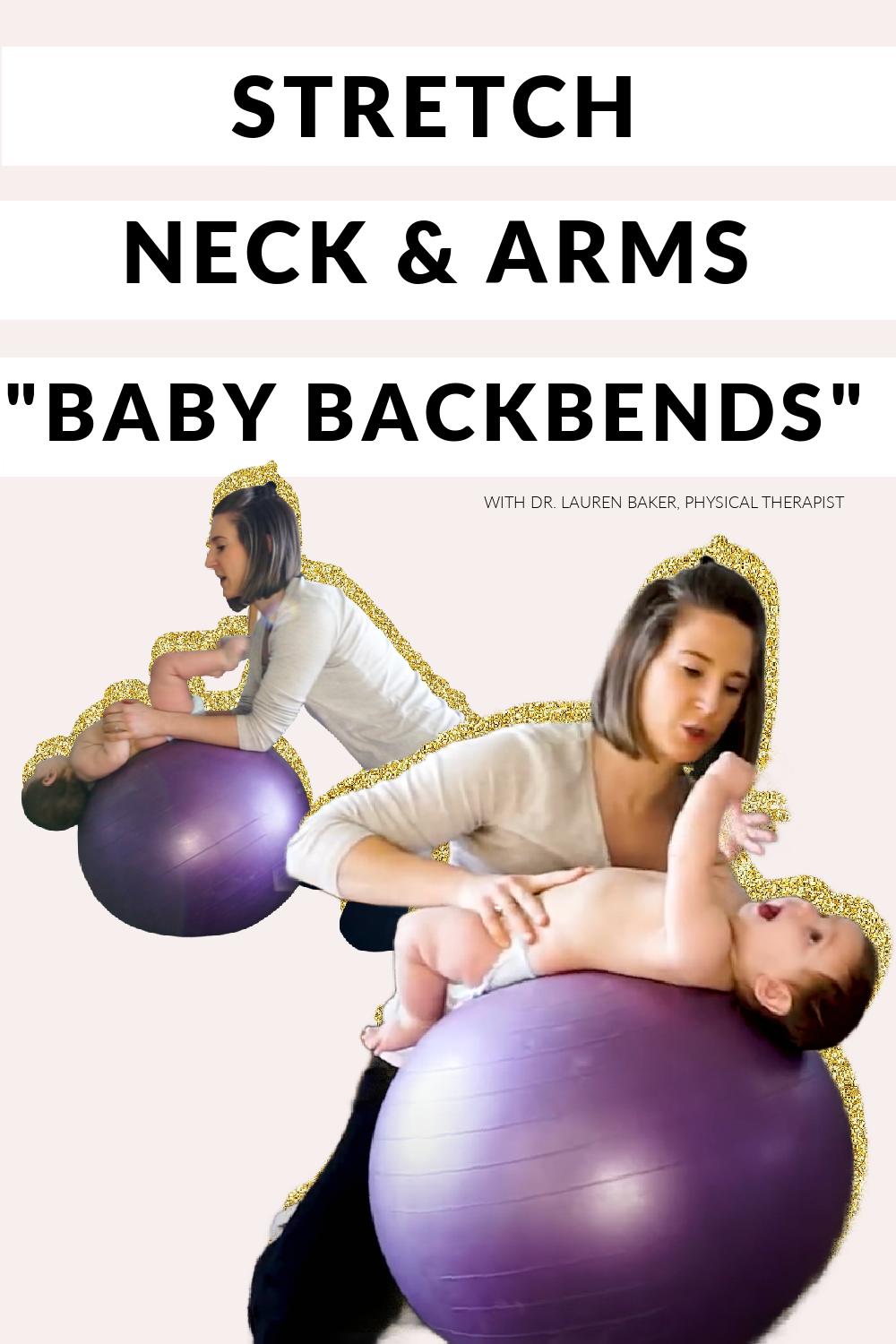How to Improve Head Control in Babies with the Pull To Sit Exercise
this blog contains affiliate links
Hey there, proactive parents! I'm Dr. Lauren Baker, a pediatric physical therapist, author, and your guide to learn how to help your babies move with confidence and ease.
Today, I'm thrilled to share with you a fun exercise known as the "pull to sit" – that's not just a game-changer for your baby's core strength but also a milestone checker used by pediatricians worldwide.
Why is the Pull to Sit Exercise a Milestone Checker?
Because it is a good gauge to see if a child is able to tuck their chin and hold it in that position against gravity when their body is going up and going down.
This shows that the neck muscles on the front (deep neck flexors) are working both in their ability to activate AND in their ability to hold that position for a prolonged period of time (long enough to not give up half way through the motion).
Babies three months and older have appropriate neck strength if they can complete a chin tuck while being brought into a sitting position and back into a lying position without letting their head fall backwards, what healthcare providers call a “head lag.”
Head lags mean that babies lack the neck strength to hold their heads in the chin tucked position throughout that movement, either because the muscles are weak or tight.
This position can also be used as an exercise to help build that neck strength in babies who are typically developing or who have developmental delays.
This exercise is truly all about empowering your little one to build the muscles needed for rolling, sitting independently, crawling, and beyond. Let's dive into making your baby's movement milestones memorable and fun!
Why the Pull to Sit Exercise is a Must-Try and Must Master Movement
Pull to sit is fundamentally a test that checks for your baby's ability to activate their deep neck flexors, tuck their chin, and use their shoulder girdle and abdomen to sit up from a lying position.
Typically Pediatricians check this motion by placing their fingers in both of a baby’s hands and the baby pulls themselves into a sitting position.
Not all Pediatricians will check both the “up” and “down,” component of the movement and traditionally if a baby is able to do the “up” portion, they are deemed appropriate in age development.
This milestone typically emerges around three months, signaling that your baby is on the right track with their head control and is ready to tackle the world—one sit-up at a time.
Observing Your Baby's Response to the Pull to Sit Exercise
Normal Response: A baby tucks their neck and uses their arms and abdomen to pull into a sitting position. The baby uses their arms to PULL themselves into sitting, meaning they bend their elbows and bring their chest forward the full way.
If a baby does not bend their elbows to pull themselves into the sit position and both of their arms stay straight DO NOT pull them into a sitting position with their arms straight. This automatically demonstrates difficulty with this movement and go into the exercise portion with your hands supporting behind their shoulders.
Weakness/Not Mastered:
Head Lag: If your baby’s head goes backward (into extension) and they are not able to keep their chin tucked during ANY part of this test (going up or going down).
This can happen if a baby hasn't had ample tummy time, hasn’t practiced this motion before, struggles to grab their feet, has tightness in their neck or chest, or hasn’t been introduced to sidelying play.
Head lag can be at the beginning, in the middle where a baby seems to “give up” and their head falls backward, or a forceful “no longer interested” by flinging their head/body backwards.
Most times, going down is going to be more difficult than going up and keeping your fingers available to support the head so it doesn’t go backwards if a baby stops maintaining the chin tuck is always encouraged.
Not using the arms to pull and keeping the elbows straight: Sometimes parents pull their babies into a sitting position with the baby’s arms straight, this can cause damage to their arm and shoulder muscles because the baby is not engaging their shoulders and bringing themselves into sitting.
When testings at the arms/hands, parents should encourage the baby to do all the work, going as slowly as needed. If the baby is not bending their arms to pull themselves into sitting, immediately provide support behind the shoulder blades and complete the screen that way.
When completing as an exercise I always continue to provide support behind the shoulder blades when doing 5-10 repetitions. I will “test” 1-2 at the hands to make sure they can do it, but prefer to always support at the shoulders to focus more on the trunk and neck strength vs arm strength.
How to Practice the Pull to Sit Exercise Safely and Effectively
For the most comprehensive information and examples using babies, please watch the youtube video below
For Babies Not Yet Pulling Actively: Modification
If your baby isn't engaging their muscles during pull to sit, don't fret! We'll start with modifications to build up their strength gently.
Elevate: Start with your baby elevated where their shoulders are above the level of the hips. I do this usually by placing their shoulders and upper back lying backwards on a boppy, but parents can do this using a wedge, cushion, or throw pillow.
Elevating the baby pulls out the toughest first 25% of the motion as gravity is the meanest between 0-25 degrees when going from lying on your back to sitting (either on your own or with help). By elevating, we simply remove that difficult portion to build strength in the easier range.
Once we master the modified version by completing x10 repetitions, moving onto harder version will be easier.
Support and Slow Motion: Support your baby under their shoulders, moving slowly to encourage them to tuck their chin and engage their core. You can add into toys in their lap when coming into sitting or using a pacifier to keep them engaged and calm.
Calming Techniques Between Reps: Offering gentle bounces or a snuggle between reps can soothe your baby, making the exercise more enjoyable.
For Babies Ready for More Challenge
Go Flat: Using an incline, like a boppy pillow, reduces the challenge by focusing on the upper 50% of the movement, making it easier for your baby to practice the pull to sit. Once they can complete x10 in a row on a boppy with chin tucked in both going up and going down, move them to flat on the floor and build up to x10 there.
Bonus for Parents & Babies: For older babies, encourage them to use their hands to pull up from the ground or from your lap. When parents place the baby on their lap they even get a core workout too.
TIMESTAMPS:
0:41 introduction to pull to sit and what it is and why doctors test pull to sit
1:43 what happens if a baby has a head lag in pull to sit
1:58 what to do if your baby is not using their arms in pull to sit
2:38 pull to sit 3-6 month olds
3:03 how many pull to sits should you do with your baby
3:15 calming techniques for babies why cry during exercises
3:30 how to support the head and neck with supine to sit
4:00 how babies tend to compensate if they have weak neck muscles
4:36 vibrating oral toy to increase the effectiveness of pull to sit
5:15 how to build the most strength for head control
5:35 what to do if your baby is struggling with pull to sit
8:07 modified pull to sit on an elevated surface
9:16 advanced pull to sit on parents legs using arms
10:03 pull to sit with hands from the ground (older baby)
TOY IDEAS:
Z Vibe Teether
Z Vibe Tips
Vibrating pull toy (similar)
Small Tummy Time Boppy
Prop a pillar
Wedge
Best Toys for Babies Learning to Roll
Best Toys for Babies
PT Approved Equipment/Containers for Babies
Tummy Time Toys
Key Takeaways for Successful Pull to Sit Exercise Sessions
Watch for Compensations: If your baby tries to use upper trunk extension instead of tucking their chin, support them under their shoulders to encourage core engagement.
Use Props: A small, vibrating oral motor toy can encourage your baby to grasp with both hands, promoting a tucked position and engagement of the right muscles.
Praise and Encouragement: Celebrate every effort, no matter how small, with lots of praises and cuddles.
Understanding Your Baby's Strength and Tolerance
Babies have varying levels of tolerance for exercises. If your baby can only handle a few repetitions before needing a break, that's perfectly okay. The goal is to encourage movement without pushing too hard, respecting your baby's limits and celebrating their progress.
Every single repetition will build on itself, if a baby has to start with x3 from an elevated surface done 5x/day, that is fine. Add them into diaper changes.
Once x3 are consistently tolerated (and may even enjoyed!) start adding repetitions until you can successful get to x10 in a row. THEN make it more challenging by going flat on the floor or decreasing the height of the incline (wedge to boppy to small throw pillow to floor).
Why Gravity Matters
Gravity is the invisible force that your baby battles with every pull to sit. Initially, gravity pushes babies harder because it is stronger in a perpendicular direction than it is at an angle, making the first part of the movement from floor to 25 degrees incline more challenging.
As your baby pulls up, gravity then goes from pushing them down to being less intense to even at times assisting them.
Curious About Learning More on Tummy Time, Rolling, or Both?
The absolute best book for parents on tummy time and rolling is: Tummy Time and Learning to Roll: A Baby Development Book for Ambitious Parents and Pediatric Healthcare Providers to Help Babies Learn to Roll Independently. The book comes with a free online video course to help parents fully understand how to complete the different exercises, printable checklists to know exactly where your baby is at, and when to reach out for additional help.
This book was written by Dr. Lauren Baker, PT, DPT, ATC, MTC, who is a Pediatric Physical Therapist in Boise, Idaho, trained in helping parents learn how to help their babies move and master their milestones. She loves teaching parents how to see how their babies are moving as well as how to influence those movements though play positions and exercises to help babies move with confidence and ease.
Tummy Time and Learning to Roll is the first book in the Proactive Play series written by Pediatric Physical Therapist Dr. Lauren Baker in order to help Ambitious Parents and Pediatric Healthcare Providers learn how to help babies master tummy time and learn to roll. It is meant to help ambitious parents understand baby development from birth to six months (tummy time to rolling).
This book is a mix of easy-to-follow and more in-depth information than is typically found in baby development books because Dr. Baker believes parents deserve to have all the information at their fingertips.
This book breaks down each piece of movement in checklists so that parents know what their babies need for tummy time and rolling. It also covers what areas might limit a child with rolling, why it is so important, and when to seek help from a pediatric PT.
This book comes with colored photos and easy-to-follow demonstration videos that can help parents implement safe, strategic play-based exercises with their babies in 20 minutes per day.
A Great Resource For:
Parents and Pediatric Healthcare Providers of babies 0-6 months
Parents of babies who are struggling with tummy time, rolling back to belly, belly to back, or only to one side
Access to simple, easy-to-follow videos of play positions and exercises
Learning the four pillars of movement needed in order to master rolling
240+ Color Photo Examples of:
Tummy Time, Sidelying, and Back Play
Developmental Toys and Equipment
Hand Placement and Strategic Play Positions
Common Areas of Restriction or Weakness
When To Reach Out For Help
What If You Want Extra Help?
If you have concerns about their movement, remember, you can always reach out to a pediatric physical therapist. It's your right as a parent to advocate for your child's development.
Sometimes, a few tips and tricks are all you need to get your baby moving better. We're here to support you and release those mama worries. If you are looking for in home pediatric physical therapy, check our listing of therapists.
For those eager to learn more or seeking personalized guidance, I offer online video parent consultations internationally which can be scheduled by clicking here. I am dedicated to answering questions and providing tailored play activities for each unique developmental journey.
When Should Babies Receive Pediatric Physical Therapy?
Parents can call and schedule with a Pediatric Physical Therapist at any time, for any concern in all fifty states without a referral from their Pediatrician.
Pediatric Physical Therapy is medically indicated in all babies who are not rolling in all four directions by six months (back to belly over their right arm AND left arm + belly to back over their right arm AND left arm).
Pediatric Physical Therapy is medically indicated if you notice a flat spot on the back of an infants head (possible plagiocephaly), a tilt of their head consistently to one side (ear to shoulder - possible torticollis), or a rotation preference of their neck (consistently look only to the right or left - possible torticollis).
Many Pediatric Physical Therapists including Dr. Baker, can successfully treat flat spots (Plagiocephaly) without a helmet with a combination of therapy and positioning strategies if seen prior to 4 months (0-3 months is ideal). Dr. Baker uses the Baby Begin Method of repositioning.
Flat spots can be due to in-utero positioning, rotational preference (right sided flatness most common) and babies are at an increased risk for flatness if they are male, were breech, multiple birth, premature, have difficulty with tummy time, or are in containers > 2 hr/day.
Final Thoughts
Thank you for joining me on this journey to strengthen your baby's core muscles through the pull to sit exercise.
Remember, every baby develops at their own pace, and the goal is to support them with love, patience, and encouragement. If you have any questions, don't hesitate to reach out for an online parent consultation.
Together, we can ensure your baby builds the strength they need to explore the world around them with confidence.
Stay tuned for more tips and tricks on helping your little one move better, and don't forget to share this post with other parents in your circle. If you haven’t yet, make sure to subscribe to the youtube channel and share it with other parents looking for proactive play ideas for their babies.
Here's to happy, healthy development for all our littles!


